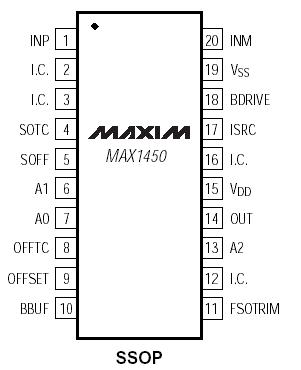Features: 1% Sensor Signal Conditioning
Corrects Sensor Errors Using Coefficients Storedin External Trimmable Resistors, Potentiometers,or DACs
Compensates Offset, Offset TC, FSO, FSO TC,and FSO Linearity
Rail-to-Rail® Analog Output
Programmable Current Source for SensorExcitation
Fast Signal-Path Settling Time (< 1ms)
Accepts Sensor Outputs from 10mV/V to 30mV/V
Fully Analog Signal Path
ApplicationPiezoresistive Pressure and Acceleration
Transducers and Transmitters
Manifold Absolute Pressure (MAP) Sensors
Automotive Systems
Hydraulic Systems
Industrial Pressure Sensors
Pinout Specifications
SpecificationsSupply Voltage, VDD to VSS.....................................-0.3V to +6V
All Other Pins ..................................(VSS - 0.3V) to (VDD + 0.3V)
Short-Circuit Duration, OUT, BBUF, BDRIVE ...............Continuous
Continuous Power Dissipation............................... (TA = +70°C)
SSOP (derate 8.00mW/°C above +70°C) .......................640mW
Operating Temperature Range
MAX1450CAP ........................................................0°C to +70°C
MAX1450EAP .....................................................-40°C to +85°C
Storage Temperature Range ...........................-65°C to +165°C
Lead Temperature (soldering, 10sec) ............................+300°C
DescriptionThe MAX1450 sensor signal conditioner is optimized for piezoresistive sensor calibration and temperature compensation. It includes an adjustable current source for sensor excitation and a 3-bit programmable-gain amplifier (PGA). Achieving a total typical error factor within 1% of the sensor's inherent repeatability errors, the MAX1450 compensates offset, full-span output (FSO), offset tempco, FSO tempco, and FSO nonlinearity of silicon piezoresistive sensors via external trimmable resistors, potentiometers, or digital-to-analog converters (DACs).
The MAX1450 is capable of compensating sensors that display close error distributions with a single temperature point, making it ideal for low-cost, medium-accuracy applications. Although optimized for use with popular piezoresistive sensors, it may also be used with other resistive sensor types such as strain gauges.

 MAX1450 Data Sheet
MAX1450 Data Sheet







